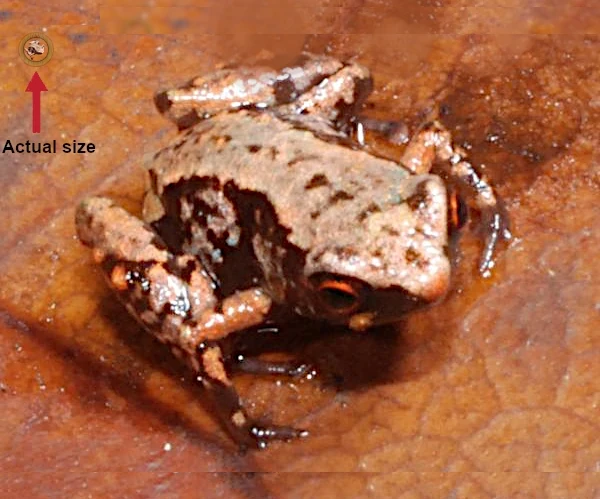
Discovered in 2009 in the humid tropical forests of Papua New Guinea, Paedophryne amauensis holds the record for the smallest known vertebrate to date. The adult reaches just 7.7 mm in length. This microvertebrate lives among dead leaves and easily blends in with the environment. Its extreme size poses biomechanical and physiological challenges, particularly in terms of thermoregulation, oxygen absorption, and reproduction.
In animals as small as this, the surface-to-volume ratio imposes physical constraints very different from those of larger animals. Physics imposes fundamental constraints arising from this ratio, which is a simple geometric quantity: as the size of an object decreases, its surface area decreases by the square (proportional to \(l^2\)), while its volume decreases by the cube (proportional to \(l^3\)). Consequently, the smaller an animal is, the larger its surface area relative to its volume.
This disproportion has major implications in biophysics:
On a macroscopic scale, these constraints are invisible. But on a millimeter scale, the world obeys physical laws where surface forces (tension, diffusion, friction) dominate over volume forces (gravity, inertia). It is in this universe that Paedophryne amauensis thrives, exploiting the physical regimes of the infinitely small to its advantage.
At this scale, the passive diffusion of oxygen through the skin becomes the main mode of respiration. Paedophryne amauensis does not have developed lungs but compensates with extremely thin and vascularized skin. Moreover, its body temperature varies with the environment: it is ectothermic and thus directly depends on the substrate. Its small size allows it to take refuge in tiny interstices, thereby reducing moisture loss, essential in a hot and humid environment. The absence of a larval stage and the direct development from egg to adult frog are also energy-efficient strategies well adapted to its scale.
One of the most critical consequences of nanoscale size in Paedophryne amauensis is its ability to exploit physical interstices inaccessible to other vertebrates. Thanks to an adult size of less than 8 mm, this microfrog can slip between the fibers of the forest litter, into gaps smaller than 1 mm, or under moist soil particles. These microrefuges constitute an essential strategy for passive regulation of body hygrometry.
In humid tropical environments, the physiological paradox is twofold:
By taking refuge in these microcavities, the animal significantly reduces the exposure of its body surface to moving air, which limits evapotranspiration. These refuges also have a relative humidity close to 100% and a stable temperature, creating a microclimate favorable for the conservation of tissue water.
This is a passive strategy, without energy expenditure, fully exploiting the physical properties of the environment on a sub-centimeter scale. This allows Paedophryne amauensis to maintain a water balance without active physiological mechanisms, which would be energy-prohibitive at its metabolic scale.
This behavior, combined with highly permeable skin and mainly nocturnal activity, reveals a remarkable example of convergence between behavioral ecology and the biophysics of multicellular microorganisms.
The vast majority of amphibians follow a life cycle in several phases: egg, aquatic larva (tadpole), then metamorphosis into the adult. However, in Paedophryne amauensis, this sequence is radically simplified: development is direct. This means that the embryo, contained in a very small but reserve-rich egg, emerges already in the form of a perfectly formed miniature frog, without going through a swimming larval stage.
This strategy has several advantages in a miniaturization context:
From an evolutionary point of view, direct development is considered an extreme neoteny adapted to miniaturization. In Paedophryne, it is a convergent response to the constraints of the microhabitat: constant humidity, limited resources, absence of large ponds, and minimal biological surface for an otherwise complex organism.
The evolution of Paedophryne amauensis, the smallest known frog in the world, perfectly illustrates the physical constraints imposed by miniaturization in vertebrates. Every aspect of its physiology, development, and behavior is dictated by fundamental biophysical laws:
This miniature frog embodies an extreme case of evolutionary specialization, where body dimensions have constrained life to reinvent its development, respiration, ecology, and even reproduction. It thus represents an ideal model for studying the limits of miniaturization in vertebrates and the solutions that biology deploys when it reaches the boundaries of the possible.